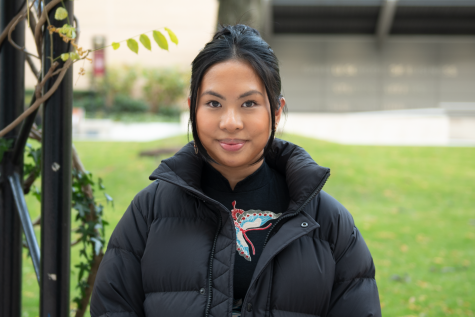To Respark a Catholic Schoolgirl’s Imagination
The impact of the Met’s “Heavenly Bodies” exhibit
(ROXANNE CUBERO/THE OBSERVER)
The Met’s “Heavenly Body” exhibit melds faith and fashion in a unique look into Catholicism and clothing.
November 8, 2018
Walking into the Byzantine and medieval art galleries at the Metropolitan Museum of Art, I felt that I was intruding upon a sacred space. However, there was no meditative hum of a choir; instead, a staccato symphony of strings echoed through the halls, emphasizing the drama of Catholicism. The pilgrims were irreverent; everyone — including me, I will admit — was elbowing each other to get the best view (and the best picture) of the revered relics of “Heavenly Bodies: Fashion and the Catholic Imagination.”
When The Met announced “Heavenly Bodies,” it was as if God was speaking to me. Catholicism defined a large part of my life. My childhood smelled like frankincense and myrrh, and I fantasized about my middle school crushes in the light of a stained glass window.
Likewise, fashion is also a large part of my life. My mother used to tell anecdotes of my grandmother, who allegedly would never let her or her sister go out unless they looked “presentable.”
All of the women in my family are devout Catholics and fervent fashionistas, myself included. However, my relationship with Catholicism is a peculiar one. I was born and raised in the Church, but I can’t remember loving it for its beliefs.
I think I loved the theatrics of the sacrament rather than the Mass itself.
Similar things can be said for the designers that are featured in this exhibition. Each designer’s respective relationship to Catholicism varies, but the Church’s impact is omnipresent, like God Himself.
Cristóbal Balenciaga was “probably the most devout,” according to Andrew Bolton, Head Curator at the Costume Institute and the mastermind behind “Heavenly Bodies.” The drapings of his evening gowns mimicked that of the Virgin Mary in a Renaissance painting. Conversely, Alexander McQueen, chief designer of Givenchy from 1996 to 2001, presented a corseted black gown over motorcycle pants, proclaiming that women, in spite of the ancient belief that they should be docile servants to the men in their lives, need to walk and work. Whether it reveals itself in imitation or critique, the Church’s influence is undeniable.
Just like my relationship with the Church, it was difficult to make a connection with any of the pieces past a superficial layer. Any connection that I did make was fleeting. I don’t know if I can attribute that to the terrifying music or the swarms of people or something else. I couldn’t feel anything past seeing the objective beauty.
Bolton believes that “exhibitions should spark debate.” It’s an invitation to question context, history and relationship, in which fashion and the Church are abundant. The Church, however, does not share the same sentiment. Catholic belief is built upon believing without seeing; believers are not scrutinizers. Perhaps it was that habit that prevented me from making a personal connection with the exhibit.
This is not to say that I’m not a believer. “Heavenly Bodies” was the first Costume Institute exhibition that I connected with in a deeply personal way. Walking through the exhibit, I could see my own fashion choices reflected in Thom Browne’s modest yet unusual silhouettes and austere color palette inspired by nuns. The same could be said for the dramatic, mystical pieces, especially the Christian Lacroix wedding ensemble that reminded me of my middle school’s yearly celebration of Nuestra Señora de Guadalupe. The designers of “Heavenly Bodies” and I are anchored by our nostalgia for our Church that finds itself in changing times.
I want to love the Church, and I think that I always have loved it. From my fashion choices to my unending compassion for others, I think it has always been there, buried deep, as if it were in the womb with me.













